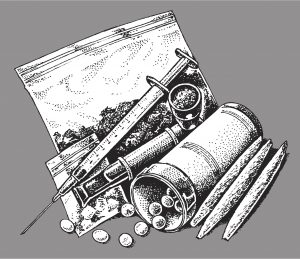by Sher Delva | Jul 24, 2017 | Addiction, Addiction Stigma, Addiction Treatment, Drug Abuse, Mental Health, Mental Health Stigma, Stigma, Therapy, Uncategorized, Withdrawal

Recently, Chris Costa was a guest on The Real Deal On… with Dug McGuirk where they discussed the topic of reinvention. Chris Costa is incredibly familiar with reinvention. He turned his entire life around after a long battle with addiction, and now shares his story of strength and hope to help others.
A little over five years ago, Chris Costa was at his breaking point. Costa describes how his family allowed him to reach rock bottom when they kicked him out of the house in the middle of February in Boston. During this time, he realized how unmanageable his addiction had become.
“I was left on my own, and I was left in the position where I really had to come to terms with the fact that I had a problem, and it became more and more apparent every day that it was a problem that I couldn’t fix myself,” he says.
Once his resources dried up, Costa did whatever he needed to support his habit and prevent feeling sick. While he is not proud of his past, he is open about it because he believes it led him to where he is today.
“I’ve had to do things that I’m not proud of. I’ve had to do things that I’ve had to make amends for. I’ve had to do things that certainly wouldn’t hold up to the values that I have today or the values that I even had then,” he admits.
“Waking up on a couch of someone you don’t even know and seeing yourself in the mirror and having the disappointment of what’s happened over the past several years hit you in what they call a moment of clarity… It’s heavy because you feel like you’ve betrayed not only yourself but everybody that cares about you, and it’s hard to understand why you’ve done what you’ve done, and it’s hard for them to understand why you’ve done what you’ve done.”
—
Shortly after his moment of clarity, Costa walked into Palm Partners on February 12, 2012, finally ready to turn his life around.
At Palm Partners, Costa learned about what it meant to be an addict. He realized there were tools that could help him navigate life, and he began to understand the reasons for his addiction.
“One of the things I’ve learned […] is we’re not bad people trying to learn how to be good. We’re sick trying to learn how to be well,” he says.
Learning to Follow Suggestions
When Costa first arrived at Palm Partners, his plan was to stay no more than 30 days before returning home. However, one of the things drilled into his mind in treatment was to take suggestions.
Following suggestions, he ended up staying at Palm Partners for 60 days and then spent six months at a halfway house. While at the halfway house, Costa was required to get a job and earn money on his own.
“I was walking to work in the middle of August in South Florida, and I was hitching rides everywhere I had to go to a meeting,” he says.
“I had to ask for rides, and ask for help, and ask what to do next. It all led to taking suggestions and asking where am I supposed to go and what I am supposed to do because everywhere I looked there were people that had more time than me, there were people that had more experience than me and there were people that had been through this. Who am I to have the answers?”
Chris Costa did not rely on handouts. Instead, he established the tools to become self-sufficient. After eight months of working the 12-steps and meeting with sponsors, Costa returned to Boston with the “toolset” he had developed while in South Florida. Chris Costa knew once he arrived, he needed to surround himself with the right people and create clear boundaries. He had to cut the people from his past that would not serve him.
“I made sure that the people I was returning to, the group of friends that I was returning to, and the people in my life that I knew I would be spending all my time with understood what I was going through, and understood what had taken place in my life,” he says.
Reflecting on the Family Program
One of the biggest revelations Costa had while at Palm Partners was when he realized his family needed help just as much as he did. The family program at Palm Partners helped his family understand his addiction, and process everything that had happened.
“They may not have been running around and doing what I had to do to not be sick, but at the same time, they’re sick in their own way in terms of enabling and not understanding the dynamics of what’s happening.”
We would like to offer you the FREE GIFT of a checklist to help decipher if you are helping or hurting a loved one who is struggling with addiction.
Click for FREE GIFT
Over the course of his recovery, Costa learned to understand and make amends with those he has hurt in the past.
“It’s a process in educating the people around you or making amends with the people you’ve hurt or burn bridges with. Not all those bridges are going to be salvageable.”
On Keeping the Momentum Going
Now over five years sober, Costa admits that life is an up and down journey. He’s learned to keep the momentum going even when life gets challenging.
“I think one of the biggest things that I try to come back to, and I think it’s said by the great Tony Robbins quite a bit, is ‘don’t let life happen to you, let it happen for you,’” he says.
Costa believes practicing gratitude is the key to navigating life when it becomes difficult.
“Finding the ability to be grateful on a daily basis, it’s a challenge. But I think us as addicts or alcoholics or people that struggle with certain issues, we’ve been through a lot,” he says. “And that gives us the ability to really appreciate some of the little nuances in life that we might not appreciate.”
Overall, Costa is grateful to have his program and tools that keep him sober. He continues to work hard as a driven Sales Director and share his incredible story of recovery with others.
“I never would be the person that I am today without having to experience what I’ve experienced and do the work I’ve had to do to get to where I am today.”
Watch the full interview to learn more about Chris Costa’s journey and delve into more important topics like achieving career goals and maintaining a strong recovery program. Costa’s story is a fantastic illustration of how working a solid program can transform your entire life. If you are struggling with addiction, please reach out. You do not have to do this alone. Call now.
CALL NOW 1-888-922-5398
by Sher Delva | Jul 18, 2017 | Addiction, Addiction Stigma, Addiction Treatment, Drug Abuse, Mental Health, Stigma, Therapy, Uncategorized

(This content is being used for illustrative purposes only; any person depicted in the content is a model)
A new Oregon bill is headed straight to the governor’s desk.
If passed, the bill would reclassify certain illicit drugs from a felony to a misdemeanor. The goal is to reduce the state’s prison population.The bill would also increase access to treatment for those without prior felonies or convictions for drug possessions, the Washington Post reports.
The bill would reduce penalties for possession of heroin, cocaine, meth and other illicit substances. The bill was already approved by the state legislature and now awaits the signature of the governor.
“We are trying to move policy towards treatment rather than prison beds,” said state Senator Jackie Winters, co-chair of the Public Safety Committee. “We can’t continue on the path of building more prisons when often the underlying root cause of the crime is substance use.”
Also included in the bill is a new initiative that will track the effects of law enforcement policies and procedures by collecting data on the demographic of Oregonians stopped by police. This initiative aims to identify any potential racist practices and address the disproportionate number of black Oregonians behind bars.
According to a 2016 report, by the Sentencing Project, blacks make up less than 2% of the state’s population; yet represent more than 9% of the state prison population as of 2014. Furthermore, the report found that the incarceration rates for black individuals are 5.6 times that of whites.
“Too often, individuals with addiction issues find their way to the doorstep of the criminal justice system when they are arrested for possession of a controlled substance,” says Kevin Campbell, executive director of the Oregon Association Chiefs of Police. “Unfortunately, felony convictions in these cases also include unintended and collateral consequences including barriers to housing and employment and a disparate impact on minority communities.”
Still, some lawmakers are wary of the bill and disagree with its “soft on crime” approach. State Senator Betsy Johnson, a Democrat who voted against the bill, said the shift toward decriminalization promotes a “hug-a-thug policy.”
The bill is headed towards the desk of Governor Kate Brown who will ultimately have the final say. In the past, Governor Brown has expressed support for the bill.
“While we still have much work ahead, HB 2355 represents an important step towards creating a more equitable justice system to better serve all Oregonians,” said Brown. “Addressing disparities that too often fall along racial and socioeconomic lines should not be political issues.”
While states like Oregon are attempting to address these disparities, on the federal level, things are headed in a different direction. Recently, Attorney General Jeff Sessions attended a D.A.R.E. training conference in Texas. While at the conference, Jeff Sessions praised the D.A.R.E. program of the 80s and 90s and hinted at bringing back that initiative today.
D.A.R.E is famously known as the “Just Say No” anti-drug initiative led by Nancy Reagan that took over school campuses in the 80s and 90s. The problem with the campaign is that there were never any proven results stating the program was effective in lowering drug use.
According to the U.S. Bureau of Justice Assistance:
“To date, there have been more than 30 evaluations of the program that have documented the negligible long-term impacts on teen drug use.”
Although the program has undergone some changes, the effectiveness of the initiative remains uncertain. Overall, it is interesting the different strategies certain parts of the country are taking in regards to addressing addiction. While some are focused on decriminalization, other areas have a tougher approach.
What are your thoughts on these new policies? Getting help can save a life, and treatment can offer a far better future than prison. If you or someone you love is struggling, please call toll-free now.
CALL NOW 1-888-922-5398
by Sher Delva | Jun 28, 2017 | Addiction, Addiction Stigma, Addiction Treatment, Drug Abuse, Mental Health, Prescription Drugs, Stigma, Therapy, Uncategorized

One Ohio City is fed up with dealing with drug addicts who overdose over and over again.
Their solution? Simple: Three strikes and you’re out.
But is this really the right way to go about this?
Recently, Dan Picard, a councilman from Middletown, Ohio proposed a new strategy to handle the influx of overdose calls in his city. He claims the city had spent $100,000 on the lifesaving drug. His solution is to limit the number of times an addict can be revived with Narcan.
“It’s not a proposal to solve the drug problem,” Picard said this week. “My proposal is in regard to the financial survivability of our city. If we’re spending $2 million this year and $4 million next year and $6 million after that, we’re in trouble. We’re going to have to start laying off. We’re going to have to raise taxes.”
While it may seem extreme, Picard believes something must be done to reduce the hundreds of thousands of dollars spent administering the overdose antidote Naloxone.
According to the National Institute of Health, Naloxone, also known by the brand name Narcan, is a “medication designed to rapidly reverse opioid overdose.”
How the Proposed Plan Works
The plan proposed states that anyone who overdoses twice must complete community service equivalent to the cost of administering the Narcan. If the person has been provided Narcan two overdoses before and has not completed the required community service requirement, dispatchers will not send help their way.
“If the dispatcher determines that the person whose overdosed is somebody’s that’s been part of this program for two previous overdoses and has not completed community service and has not cooperated in the program, then we wouldn’t dispatch,” Picard explains.
Middletown has seen a significant spike in overdoses. Just last year alone, there were 532 overdoses reported. It may sound extreme, but Picard insists the city cannot afford to continue responding to overdoses at the same rate.
“We’ve got to do what we’ve got to do to maintain our financial security, and this is just costing us too much money,” he told NBC affiliate WLWT.
This city of Middletown, Ohio spent three times as much on Narcan this year as they did all of 2016. The numbers in 2017 already surpass that of the previous year at 577 overdoses so far.
Numbers Soar Throughout Ohio
All across Ohio, communities like Cleveland, Elyria, Parma, Chardon, and others have seen people need Narcan again and again after overdosing on opioids.
As of right now, the fire department is required by law to provide Narcan in response to an overdose. The legal department is reviewing this plan proposed by Picard. In the meantime, the fire department is applying for grants and donation to increase funds for Narcan.
Sal Valdez, the Clinical Coordinator for American Medical Response in Rochester, stated to a local news station, that he responds to at least four drug overdoses every day and about 80 every month. Each time, paramedics administer Narcan, they could need multiple doses. He also notices overdoses occurring in similar areas to repeat offenders.
“Sometimes we do know these patients by name,” Valdez said. “In my experience, we do see the same patients over and over again, and we respond to the same locations.”
Way Too Extreme?
One study estimates the cost of the prescription drug opioid epidemic costs American society $78.5 billion. Regardless, many find this proposed strategy way too extreme. This could mean the difference between life and death for some, preventing them the opportunity to recover.
Daniel Raymond, the deputy director of the Harm Reduction Coalition, told the Washington Post, that he’s “disappointed” by Picard’s plan of action. He noted that the proposal was an insult to families of loved ones struggling with addiction.
“Ohio is an epicenter of the heroin epidemic … and you can empathize with the frustration, but not with this type of solution,” Raymond told The Post.
What are your thoughts on this plan? Personally, it feels like this proposal only further stigmatizes the perception of addiction. Would we treat any other illness in this manner?
We believe recovery is a better option. Addiction should receive treatment just like any disease. Please seek help if you are struggling with substance abuse. Please call toll-free today to speak to an addiction specialist. We want to help.
CALL NOW 1-888-922-5398
by Sher Delva | Jun 22, 2017 | Addiction, Addiction Medicine, Addiction Stigma, Addiction Treatment, Stigma, Therapy, Withdrawal
 The opioid epidemic continues to reach epidemic numbers, and with the increasing overdoses comes increasing cases of hepatitis C. New cases of hepatitis C have nearly doubled over the past few years. Furthermore, those with opioid addiction are more likely to suffer from a variety of health disorders, complicating treatment for substance use disorder.
The opioid epidemic continues to reach epidemic numbers, and with the increasing overdoses comes increasing cases of hepatitis C. New cases of hepatitis C have nearly doubled over the past few years. Furthermore, those with opioid addiction are more likely to suffer from a variety of health disorders, complicating treatment for substance use disorder.
Hepatitis C is among the most concerning disorder to affect people with opioid addiction. People who abuse opioids are 9.1 times more likely to have hepatitis-C (HCV), in comparison to those who did not abuse opioids, according to an analysis by the health care company Amino. Amino drew data from the claims of 3.1 million privately insured patients between 2014 and 2016.
As the opioid epidemic spreads throughout the country, new cases of HCV have skyrocketed. In 2014, there were an estimated 30,500 new cases in the United States. This is nearly double the number of new cases in 2011, according to STAT News.
The CDC reports that new HCV infection is rising specifically among intravenous drug users under 40 years old, particularly in more rural areas. People with opioid use disorder are more likely to drink to excess, and more likely to have suicidal ideation.
While these numbers are shocking, many are not surprised:
“It’s known that people with co-occurring behavioral and mental health issues are at high risk for addiction even when prescribed opioids for a bonafide prescription medical use,” Dr. Anna Lembke, a Stanford University psychiatrist, and opioid addiction expert, told Amino.
However, Lembke was particularly moved by the fact that people with opioid addiction are seven times more likely to suffer from “failed back syndrome,” a chronic condition that is diagnosed following back surgeries.
“What I thought was really interesting was the correlation with failed back syndrome,” she said. “Perhaps failed back syndrome is a risk factor for developing an opioid use disorder—and that could be part of the reason why this community experiences such chronicity and lack of improvement. This is a subgroup that’s especially vulnerable to opioid misuse.”
The data collected by Amino looked at health claims among people with a variety of insurance codes, representing conditions from opioid dependence to opioid abuse in remission. Amino is a private insurer, and the data revealed a sharp increase in opioid abuse specifically among those with private insurance. According to the data, there was a six-fold increase in opioid-related insurance claimed between 2012 and 2016 among private insurers.
However, Lembke notes that this sharp increase may be underrepresented:
“Patients don’t want to carry them on their charts, and doctors don’t want to stigmatize their patients,” said Lembke. “But they will go ahead and chart it if there’s utility in it. And the utility is you can’t get buprenorphine, methadone maintenance, or naltrexone paid for by a third-party payer unless it’s diagnosed.”
Last month was Hepatitis Awareness Month. The treatments for hepatitis C have really come a long way, and it no longer as life endangering as It once was. The key is to seek treatment early. Unfortunately, due to the stigma of addiction, many are afraid to get tested.
Studies like these show that the numbers are not improving. Those with opioid addiction seriously need testing to prevent the disease from progressing any further. Please do not feel shame about testing for this disorder. Furthermore, if you are struggling with substance use disorder, please reach out to us. We have the tools to guide you to a sober life. Do not wait. Call today.
CALL NOW 1-888-922-5398
by Sher Delva | Jun 20, 2017 | Addiction, Addiction Stigma, Drug Abuse, Mental Health, Prescription Drugs, Stigma, Therapy, Uncategorized, Withdrawal
 Yesterday, we covered recent coroner reports that revealed that actress Carrie Fisher has drugs in her system days before her death. The toxicology reports found evidence of heroin, MDMA along with cocaine in her system.
Yesterday, we covered recent coroner reports that revealed that actress Carrie Fisher has drugs in her system days before her death. The toxicology reports found evidence of heroin, MDMA along with cocaine in her system.
It’s estimated that cocaine was used three days before her death. However, it remains uncertain when the heroin and MDMA were used. Still, despite the discovery, the coroner’s office cannot determine whether or not drugs played a role in Fisher’s death. A variety of other factors such as a heart condition affected the actress as well. Therefore, a cause of death could not be determined.
Daughter Tells It Like It Is
Now, Billie Lourd, the only child of Carrie Fisher, recently opened up to media outlets to confirm what the coroners cannot: her mom died from drug addiction. While this is far from surprising for her fans, Lourd’s bold act of ownership is what her Mom would have wanted.
Carrie Fisher has always made an effort to publicize her journey with mental illness and addiction. She was diagnosed with bipolar disorder at just 24 years old and battled a serious drug addiction most of her life.
Lourd made an emotional statement regarding her mother. While reports stated it was uncertain whether drugs caused her death, Lour was less ambivalent, declaring that she was certain her mother died due to her drug use.
“My mom battled drug addiction and mental illness her entire life,” Lourd said in a statement to People magazine. “She ultimately died of it. She was purposefully open in all of her work about the social stigmas surrounding these diseases.”
“She talked about the shame that torments people and their families confronted by these diseases. I know my mom. She’d want her death to encourage people to be open about their struggles. Seek help, fight for government funding for mental-health programs. Shame and those social stigmas are the enemies of progress to solutions and ultimately a cure. Love you, Momby.”
Carrie Fisher: Forever an Advocate
Carrie Fisher has always been one of the most powerful advocates for people struggling with substance use disorders. She used her fame from the Star Wars franchise to stimulate discussion and awareness about drug addiction, mental illness and the challenges of recovery.
“I did drugs because they alter you in a way you can’t alter yourself if you’re not comfortable in your own skin,” she told Mirror Online in 2015.
The actress admitted she used drugs as self-medication for her bipolar disorder. She stated that she was not ashamed about her mental illness, and instead hoped more people would come forward seeking treatment.
“One of the things that baffles me (and there are quite a few) is how there can be so much lingering stigma with regards to mental illness, specifically bipolar disorder. … At times, being bipolar can be an all-consuming challenge, requiring a lot of stamina and even more courage, so if you’re living with this illness and functioning at all, it’s something to be proud of, not ashamed of,” she said In her 2008 memoir, Wishful Drinking.
Results of Toxicology Report
A full autopsy report was not conducted at the request of Fisher’s family. The toxicology report stated it was uncertain whether substances played a role in her untimely death.
“Based on the available toxicological information, we cannot establish the significance of the multiple substances that were detected in Ms. Fisher’s blood and tissue, with regard to the cause of death,” stated the report.
Lourd is taking the extra step to confirm what most try to disguise. Carrie Fisher was never ashamed to discuss her struggles with addiction. She was a voice to those who feared to come forward. If you struggle with addiction, mental illness or both, please reach out. Call now. We want to help.
CALL NOW 1-888-922-5398
by Sher Delva | Jun 20, 2017 | Addiction, Addiction Stigma, Drug Abuse, Mental Health, Stigma, Therapy, Uncategorized

Autopsy reveals Carrie Fisher had cocaine, ecstasy, and heroin in her system before death
Six months after Carrie Fisher’s death, new reports reveal the cause of death.
Coroner’s officials ruled that Fisher died from sleep apnea and a combination of other factors. The “Star Wars” actress fell ill on the plane last year, but investigators could not determine what impact drugs had on her death.
New Toxicology Reports
Now, toxicology reports reveal that Fisher had cocaine in her system and could have taken cocaine three days prior to the December 23 flight on which she had a heart attack. Fisher died four days after the flight.
The reports also say traces of heroin, other opiates, and ecstasy were found, but they could not determine when Fisher took these drugs. The findings were based on toxicology screenings taken when the “Star Wars” actress arrived at a Los Angeles hospital.
The full report contains a detailed explanation of the results, such as why investigations believe cocaine was taken by the actress at least three days prior to her flight. It also states that while heroin is detectable in the system for a briefer period of time, investigators could not determine when Fisher took it or ecstasy. Toxicology tests also found opiates in Fisher’s system, including morphine, although reports state this could be a byproduct of heroin.
“Ms. Fisher suffered what appeared to be a cardiac arrest on the airplane accompanied by vomiting and with a history of sleep apnea. Based on the available toxicological information, we cannot establish the significance of the multiple substances that were detected in Ms. Fisher’s blood and tissue, with regard to the cause of death,” the report states.
Other Potential Factors
Among the factors that contributed to Fisher’s death was the buildup of fatty tissue in the walls of her arteries, a condition known as atherosclerosis.
A phone message left for Fisher’s brother, Todd, was not immediately returned. Todd Fisher said in a statement Friday that he was not surprised
“I would tell you, from my perspective that there’s certainly no news that Carrie did drugs,” Todd Fisher said.
Carrie Fisher has been open about her drug use to the media and wrote about her struggles extensively. Many of the drugs were prescriptions by doctors to help Fisher overcome her mental health conditions, Todd Fisher noted. Fisher had long battled drug addiction and mental illness.
Fisher started smoking marijuana at 13, used LSD by 21, and was diagnosed with bipolar disorder at 24. Doctors treated her with medication and even electroshock therapy.
“I am not shocked that part of her health was affected by drugs,” Todd Fisher said.
So what was the cause of Fisher’s death?
Todd Fisher believes it was a combination of Fisher’s heart condition along with her smoking habits, and the medications she took.
“If you want to know what killed her, it’s all of it,” he said.
Carrie Fisher opened up in 2016 about her life-long struggles with insecurity. She admits she dealt with it extensively in the original “Star Wars” movie in the 70s. She even admitted to an affair with co-star Harrison Ford, at only 19 years old, in which she felt tremendous guilt.
Furthermore, Fisher has revealed challenges with body image after gaining weight. Before filming “Star Wars: Episode VII”, Fisher admits she was told to lose 35 pounds.
—
Fisher’s life has not always been easy. However, we will always love and appreciated her work. Addiction is a disease and should be treated as such. Fisher’s struggles are not a reflection of who she is as a person. She struggled with the disease of mental illness and addiction like many do. If you struggle with the same issues, please reach out. We want to help you before it is too late. Call now.
CALL NOW 1-888-922-5398



 The opioid epidemic continues to reach
The opioid epidemic continues to reach  Yesterday,
Yesterday, 

